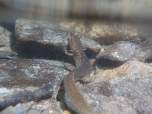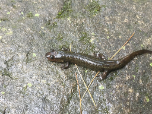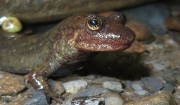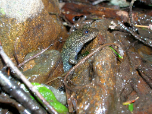Cherokee Blackbelly Salamander (D. gvnigeusgwotli)
Description: The species name means black belly in the Cherokee language. The blackbelly salamander is a medium-sized salamander growing to about 3.9 to 7.1 inches long. It is sturdily built with a long tail. The ground colour is dark brown or black with two rows of small pale spots along each side of the back. The underside is usually black but may have pale flecks in young individuals.
They are highly variable in color, with the ground color ranging from a light gray to deep black. Their color has been recorded in one study to be related to their habitat. Populations that are only a few meters away can have drastic differences phenotypically, depending on the habitat differences. This study showed that two populations in the same stream were vastly different in color. This could be related to the amount in shade, leaf litter, and rock color of their habitat.
Habitat: In or along swift, boulder-strewn mountain streams. Also near waterfalls and places where cold water drips or seeps. Refuges are in rock cevices or in burrows. Usually under rocks in daytime. Sometimes basks in sun on wet rocks. Eggs are laid on undersides of rocks or on tree roots in streambed, apparently in headwater tributaries in North Carolina.
Range: Primarily in the Great Smoky Mountains of western North Carolina and eastern Tennessee with isolated genetic and specimen records from the Unicoi, Great Balsam, and Bald Mountains.
Found in these States:
NC |
TN
Diet: Their diet shifts throughout the different stages of their life. During their larval stage they prey mostly on insect nymphs, when juveniles they will eat a mixture of aquatic and aerial prey, and when they are adults they eat aquatic, aerial, and terrestrial prey including other salamanders.
Reproduction: Breeding takes place in the late spring. The female attaches fifteen to forty eggs to the base of submerged boulders. The eggs hatch in about three months and the larvae develop slowly, undergoing metamorphosis into juvenile salamanders about three and a half years later.
»» Kingdom: Animalia - Animals
»» Phylum: Chordata - Chordates
»» Subphylum: Vertebrata - Vertebrates
»» Class: Amphibia - (Amphibians)
»» Order: Caudata - Salamanders
»» Family: Plethodontidae - Lungless Salamanders
»» Genus: Desmognathus
»» Species: . gvnigeusgwotli - Cherokee Blackbelly Salamander
This article uses material from the Wikipedia article "Blackbelly Salamander", which is released under the Creative Commons Attribution-Share-Alike License 3.0. Content may have been omitted from the original, but no content has been changed or extended.
|













